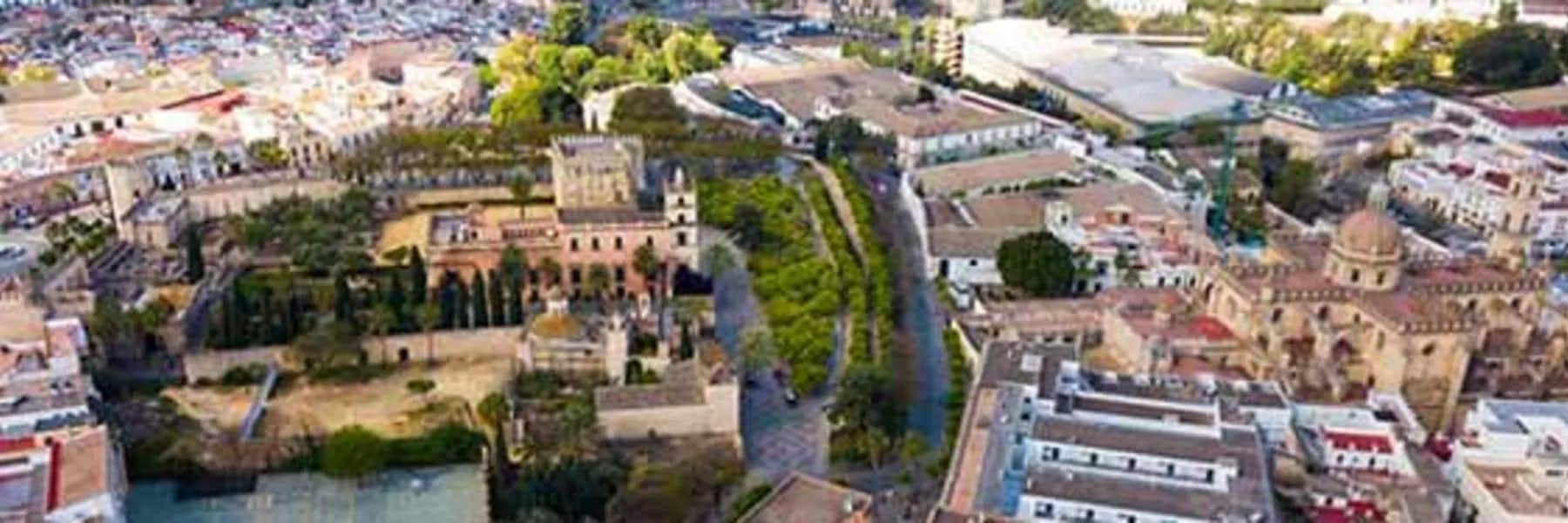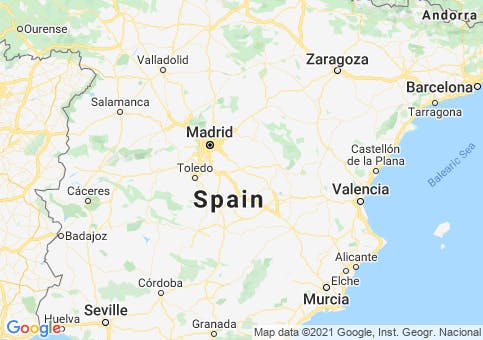By Cila Warncke
Jerez de la Frontera lies between nine and twelve miles as the crow flies from Spain’s southern Atlantic coastline. The city of some 210,000 people is famed for sherry, horses, and flamenco. It is proud, friendly, raucous, and deeply traditional. Despite its hot climate, minimal cost of living, and good transport connections, it attracts few outsiders long-term; almost none from other parts of Spain.
Retire in Jerez

A paucity of expats distinguishes Jerez from the English-speaking enclaves of the Costa Sol, just two hours away, guaranteeing its authenticity and bargain-basement cost of living. If you want history, culture, architecture, and Spanish life as lived by Spaniards, Jerez is unparalleled.
There is a small English-speaking community, many of whom run language schools (an option for part-time teaching work, if desired). Most people over forty speak minimal English, so it helps to know basic Spanish. However, the government has made a huge push for language education in recent years; English is required from primary school through university. This means there is always someone to hand to help out in a linguistic jam.
Essential businesses like banks and real estate agents have English-speaking staff, so it is easy to manage personal affairs. If you live in or near the old town, you can walk most places comfortably, or hop on a city bus. The train and bus stations that connect Jerez to Cadiz, Seville, and numerous smaller towns are a 20-minute stroll from the main square. Apartment living is the norm, both in the old town and newer zones on the periphery. Some neighborhoods have rows of duplexes with small gardens, for those who prefer a more suburban experience. These developments usually include private parking. Apartment-dwellers should consider renting a garage space for $60 a month to save the headache of street parking.
Despite its southerly latitude, Jerez has distinct seasons. Summers are bright and hot, with temperatures in the 80s F from June to September. Spring and Fall are cooler but comfortable; January and February can be bitter. One local weather phenomenon is the levante, a fierce east wind that scours the city with desert sand from north Africa. Another is the rainstorms which can inundate Jerez in a matter of hours. These extremes are rare, though. You can sit outside at a cafe most months of the year.
Get Your Free Spain Report Today!
Get Your Free Spain Report Today!
Learn more about the lower cost of living in Spain and other countries in our free daily postcard e-letter. Simply enter your email address below and we'll also send you a FREE REPORT — Live the Good Life in Sunny, Affordable Spain.

By submitting your email address, you will receive a free subscription to IL Postcards and special offers from International Living and our affiliates. You can unsubscribe at any time, and we encourage you to read more about our Privacy Policy.
Lifestyle in Jerez
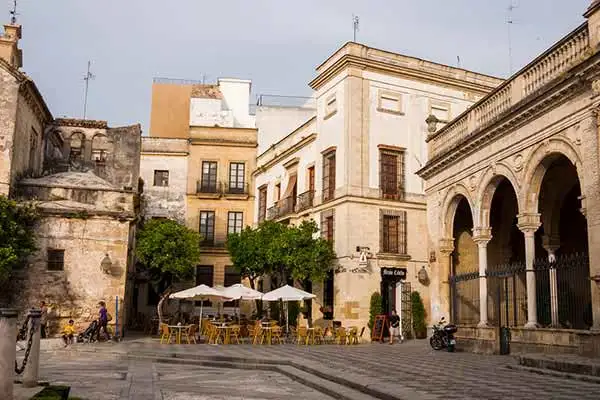
Though hard-working when a task is at hand, Jerezanas make no apology for living for the pleasures of food, family, and faith. People eat up to five times a day, starting with café con leche and toast around 9 a.m, coffee (or sherry) and a tapa at 11 a.m., a long lunch at 1 p.m. (followed by siesta), an afternoon snack (merienda) between 4 p.m. and 5 p.m., and a sumptuous dinner at 10 p.m. to 11 p.m. The latter is often followed by drinking and singing until the wee hours, including on week nights.
The cobbled city streets ring at all hours with conversation, laughter, clinking glasses, shouting children and the staccato of palmas, the hand-clapping that forms the rhythmic backbone of flamenco.
Jerez was a Moorish city for over 500 years before its conquest by Catholics in 1264. This history lives in its architecture, as well as its iconic music. The old town is dominated by the Alcazar, an 11th century fortress that was once a self-sustaining city. Its dust-colored exterior belies the elegance and symmetry inside, where you can wander through gardens, a mosque, and baths whose vaulted ceilings are pierced with star-shaped holes that create a permanent twinkling twilight.
Opposite the Alcazar, and almost equally popular as a wedding photo backdrop, is the Cathedral of the Holy Saviour. Jerez’s social calendar revolves around weddings, baptisms, and Saint’s days, all of which are marked with immense ceremony. Religious processions (called cabalgatas) regularly set off from one of the city’s two dozen churches and parade through the streets in the colorful robes of one brotherhood (hermandad) or another, surrounded by residents dressed in Sunday finest, knocking back sherry as they salute the passing icons.
The entire city downs tools for Feria in May and Semana Santa, the week before Easter. Preparations for each of these epic celebrations begin weeks in advance. The Feria began as a horse-trading fare and buying, selling, and showing Andalusian horses is still an important part of the event; so too are the bands, cabanas, amusement park rides, and bars built in the city’s principal park, turning it into a round-the-clock party. Prior to Semana Santa, viewing stands are built along the main streets and plazas, and more than 40 hermandades practice marching their designated routes while bands fill the air with solemn music.
Weddings are no equally grand. From Easter till June, the central plazas are packed each weekend with gleaming four-horse carriages, luxury cars, and crowds in tuxedos and jewel-toned formal dresses. You don’t need an invite to settle on a bench, or at a cafe table, and enjoy the spectacle.
Next-door to the Cathedral is Jerez’s other principal house of worship: the Gonzalez-Byass factory where Tío Pepe sherry is produced. Sherry is the lifeblood of Jerez, enjoyed by much of the mature population for breakfast and lunch, as well as before, during, and after dinner. On entering the city, you smell the sweet, heady must of fermenting grapes from the city’s dozens of bodegas (wineries). If you care about fine wine, history, or both, a tour of Gonzalez-Byass is a great place to start. It explains sherry’s distinctive production process and colorful past, and pours generous tasters of the principle styles including pale, dry finos; rich, russet olorosos; and the unctuous sugar-punch that is Pedro Ximenez. Aficionados could spend happy years working their way around Jerez’s bodegas, immersing themselves in its culture one glass at a time.
Local cuisine tends to bold, rich, sweet flavors that complement sherry. Drinks are served with bite-sized breadsticks called picos, cubes of pungent goats’ cheese (payoyo), or herb-spiked olives. Seafood is excellent and inexpensive, often simply grilled with garlic and oil. Fried or roast pork is another favorite. In season, snails, served in a glass, are a local delicacy. They are sold, live, by the carrier bag at the sprawling central market (mercado de abastos). Housed in an airy Neoclassical building, it is worth visiting for the architecture alone. Inside, it is equal parts live entertainment and budget-conscious shopping destination. A week’s supply of fruit and vegetables (most local) costs about $18, half-a-dozen farm fresh eggs $1.50, a kilo of sea salt from the nearby coast $1.20. Stalls are replete with regional goods including honey, nuts, figs, olives and olive oil, and fresh-off-the-boat fish.
Cost of Living in Jerez
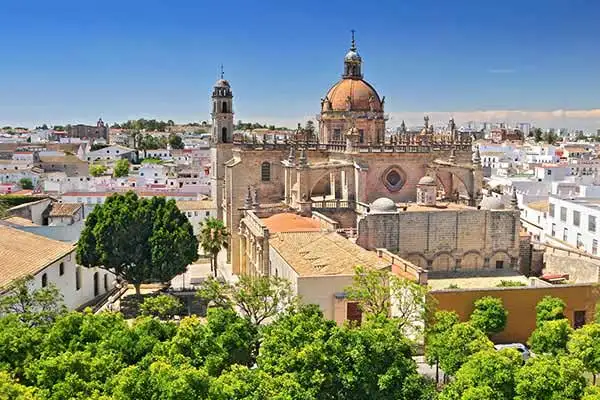
The mercado is not the only place expats can get reverse sticker shock. Casual dining costs next to nothing: a sandwich (bocadillo) or a wedge of tortilla de patatas plus a drink will fill you up and set you back $3.60 to $4.80; a beer or sherry is $1.20 to $1.80 at most bars (known as tabancos, not to be confused with small shops which are estancos). Restaurants specialize mainly in regional cuisine, with meat or seafood dinner mains for $14.50 to $18.00.
Property prices are likewise modest. The average cost is $1,340 per square meter to buy (versus $3,400 in Madrid and $3,250 in Barcelona) and $8.20 to rent compared to $17 in Madrid and Barcelona. A two-bedroom, two-bathroom apartment will cost around $120,000 in central Jerez; a larger, more modern apartment to the north or south will be around $180,000 to $220,000.
Rentals are around $600 for a two-bedroom, two-bathroom property, depending on the size and location. Three and four-bed homes can be had for around $840.
Public transportation is reliable and inexpensive. With the purchase of a rechargeable swipe card, a 45-minute bus journey to Cadiz is $3.60, to Sanlucar de Barrameda (famous for manzanilla, its version of fino sherry) is $1.60and coastal beauty spot Chiclana is $2.60. The international airport is 15 to 20 minutes and $18 by taxi. There is sporadic bus and train service, too; if it suits your flight time you can get to the airport for a couple of dollars.
Below is a breakdown of average monthly expenses for two people living in Jerez:
| Expense | U.S. $ |
|---|---|
| Rent (two-bedroom apartment) | $715 |
| Electricity | $48 |
| Gas (heating/stove) | $18 |
| Groceries | $400 |
| Cell plan | $35 |
| Internet | $30 |
| Car (maintenance/fuel) | $120 |
| Health insurance (private) | $180 |
| Dining out | $170 |
| Total: | $1,716 |
Things to Do in Jerez, Spain
By Cila Warncke
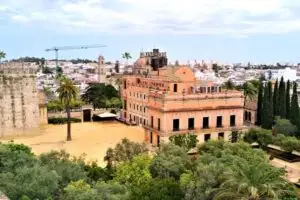
It is a mystery to me why Jerez is not overrun with tourists since its traditions and culture form the popular image of Spain: flamenco, high-stepping horses, bull-fighting, sun-scoured haciendas, ham, wine, and olives.
The name Jerez—xeres in Old Spanish—was Anglicized to sherry. Like its eponymous wine, the city is piquant, distinctive, the product of centuries of cultural mixing and fermentation. It is the only place in Spain I’ve ever seen a horse and cart cut through a roundabout towards IKEA, the only one where grandparents knock back drinks on the street at five in the morning, the only one where the sky turns to liquid ink on a summer’s night and flows with stars.
To get the measure of Jerez, stay in a high-ceilinged, white-walled converted house in the old town. What you lose in mod cons and swimming pools will be rewarded with immersion in the inimitable color and clamor of authentic Andalusian life.
Historic Jerez

Though modest in size, the Archaeological Museum of Jerez houses artifacts that date back around 500,000 years. Its history as a settlement began nearer 2,500 BC and can be traced through the relics of Phoenician, Greek, Roman, and Moorish cultures. The latter bequeathed the city its most beautiful enclave, the Alcazar.
Dust-hued, time-softened stone walls belie the verdant interior. Like a theatre curtain, they hide a small world of intrinsic harmony and sufficiency. Thought to have been built in the 11th century, the Alcazar served as residence and fortress of Moorish rulers. As such, it contained everything a well-appointed estate needed, including baths, gardens, a reservoir, a bakery, and a mosque. The latter is the last remaining mosque in the city, a graceful counterpoint to the flying buttresses and scowling gargoyles of the Cathedral of the Holy Saviour, a stone’s throw away.
Built several hundred years after the Alcazar, on the remains of another mosque, the Cathedral is a photogenic melange of Gothic, Baroque, and Neoclassical architecture. One of its notable ceremonies is the annual blessing of the grape harvest, held on September 8. In true Jerezana style, this involves ornate religious symbolism, fancy dress, loud music, and a lot of sherry.
Wine and Culture
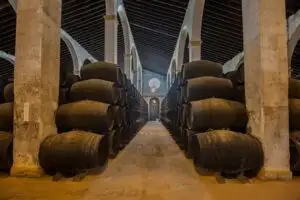
©iStock.com/javarman3
Sherry is more than a once-a-year fiesta in Jerez; it is a way of life. On arriving in the city take a deep breath. That sweet, heady fug is the must of millions of grapes being transformed into what the Spanish call vino generoso—generous wine. Visiting a bodega, or three, is an essential part of any trip to Jerez. Gonzalez-Byass, which makes Tio Pepe, is the largest and most commercial. It is a good place to start for an introduction to the solera sherry-making method and you get to ride through its luxuriant gardens on a miniature train. Other notable bodegas include Lustau, Diez Merito, Tradicion (which dates back to 1650), and Fundador (a relative newcomer born in 1730). Sherries range in style from ultra-dry fino, to semi-sweet oloroso, to stand-a-spoon-in-it Pedro Ximenz but they are all—and this is worth remembering when confronted with 150ml ‘tasting’ pours—more than 15% alcohol. The generosity is best enjoyed with circumspection; or a hearty meal.
Food in Jerez is paired to the wine, rather than vice versa, with strong flavors and rich textures. A popular bar snack is deep-fried stripes of pork belly called chicharrones which are accompanied by baskets of bite-sized bread sticks called picos. Another typical plate is migas: chorizo, bread crumbs, and garlic fried in pork fat. If three ham-based meals a day is too much, there is excellent seafood to be had (Jerez is about 20 miles from the coast) and the local payoyo goats cheese is a satisfying dish in itself. All of these delights are best enjoyed out of doors.
Central Jerez is a tangle of mellifluous plazas—Arenal, Angustias, Plateros, Peones, Primo de Rivera – each appointed with cafes and benches from which to watch the world go by. Jerezana life happens in the street, with everyone from infants to great-grandparents congregating for morning churros and chocolate, midday sherry and tapas, afternoon merienda, dinner then more sherry. A few hours of people-watching in a plaza is a better cultural education than any formal tour!
Two other spectacles merit seeking out—horses and flamenco. Jerez is home to the Royal Andalusian School of Equestrian Art. Its leafy compound includes expansive stables, two museums, training areas and performances. These offer a good opportunity to see one of the world’s oldest and most revered equine breeds in action. Andalusians, known as pura raza espanola (pure-bred Spanish) in their homeland, have been prized by kings and cavalry for their elegance, power, and courage for over 500 years. Shows include the choreographed hoof-work of classical dressage and the drama of traditional Spanish riding known as doma vaquera.
Flamenco has a similarly long, though, scholars point out, somewhat tarnished history. Its origin in the Roma (Gitano) community and Moorish culture made it unpopular with Catholic leaders and the cultural elite. But the raw, sensual, plebeian art persisted and triumphed. Amateur cantantes work the plazas for spare change and bars around the city showcase professional singers, dancers, and guitarists.
Out-of-Doors

Jerez is about equidistant from the beach towns of Sanlucar de Barrameda to the north and El Puerto de Santa Maria to the south. These outposts comprise the other two points of the ‘sherry triangle’; Sanlucar is famed for its dry manzanilla sherry; El Puerto was the main departure point to export vino. Between Puerto and Sanlucar lie miles of white sand beaches, most far less developed than their Mediterranean equivalents. On summer days the ocean is Caribbean blue; equally breathtaking are its roaring winter storms.
North-west of Jerez is Doñana National Park, a UNESCO World Heritage site and bird-watching paradise. It is a couple hours’ drive, as the motorway loops around the east side before accessing it from the north, making it a good day-trip destination. The park comprises woods, wetlands, and coast, and is a beacon for migratory birds including the critically endangered imperial eagle. It is also the main stronghold of the world’s most threatened wild cat, the Iberian lynx. Self-guided tours are not allowed; but Doñana Reservas offers group and private expeditions. One perk of the tours is they depart from El Rocio. This white-washed village is famed for its classic architecture, sand streets, and inhabitants that run errands on horseback.
Must See:
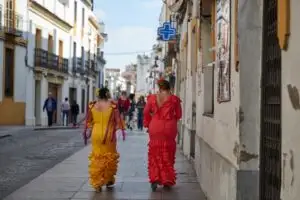
Flamenco Festival
Each February for the past 24 years, Jerez has filled with flamenco aficionados from around the world—the Japanese are particularly partial. In 2021, the festival moved to May 6 to 22 as a Covid-19 measure. Programming includes ballet, traditional flamenco, guitar, singing, drama, and even harp-playing. It is also popular for its professional dance classes and innumerable informal performances.
More information online here: Festival de Jerez
Feria de Caballo de Jerez
Once a humble horse-trading fair, the Feria de Caballo, known simply as Feria, takes place in early May. The city shuts down as everyone from eight months to 80 years old climbs into fancy dress and makes their way for the fairy-lit Parque Gonzalez Hontoria. Horses are still present but, for most, the focus is the dozens of casetas (small bars) where eating, drinking, dancing, and flirting carry on till the early hours.
More information online here: Jerez Feria
Semana Santa
The week before Easter in Jerez is a spectacle that is dazzling, or unnerving, depending on your point of view. Numerous Catholic hermandades—brotherhoods—spend months practice-marching along their designated procession route carrying litters weighted with sandbags to mimic the heft of the icon they will bear. Each night of Holy Week, the air shivers with the plaintive notes of reed instruments and reverberates with drums as cloaked figures in pointed hoods march in somber time. Locals dressed in Sunday best pack every inch of the route. Fortunately, the solemnity does not preclude sherry consumption.
More information online here: Semana Santa
Featured Image Copyright: ©iStock.com/JackF
Get Your Free Spain Report Today!
Get Your Free Spain Report Today!
Learn more about the lower cost of living in Spain and other countries in our free daily postcard e-letter. Simply enter your email address below and we'll also send you a FREE REPORT — Live the Good Life in Sunny, Affordable Spain.

By submitting your email address, you will receive a free subscription to IL Postcards and special offers from International Living and our affiliates. You can unsubscribe at any time, and we encourage you to read more about our Privacy Policy.
